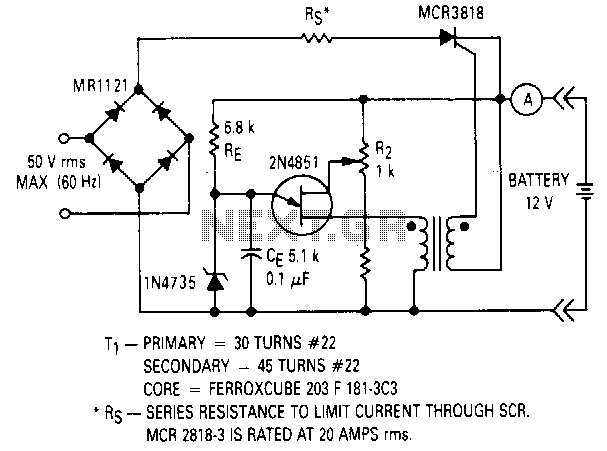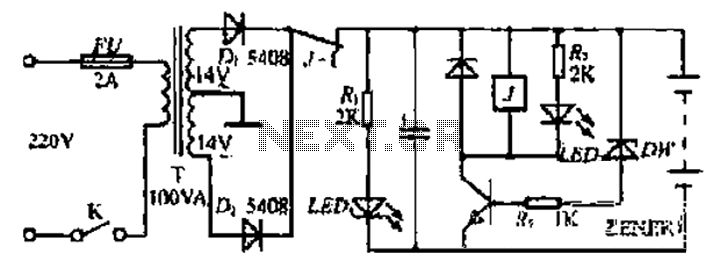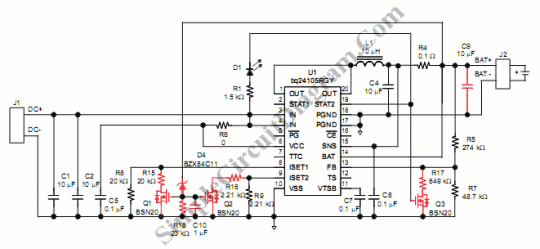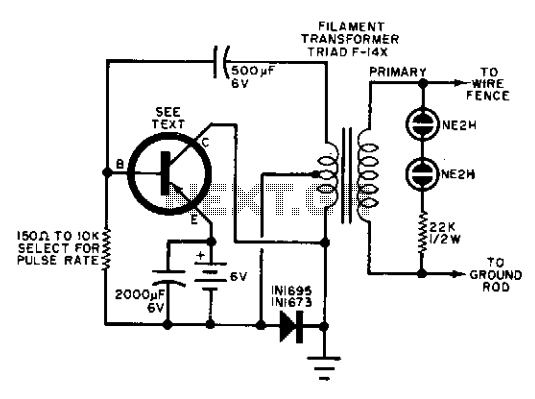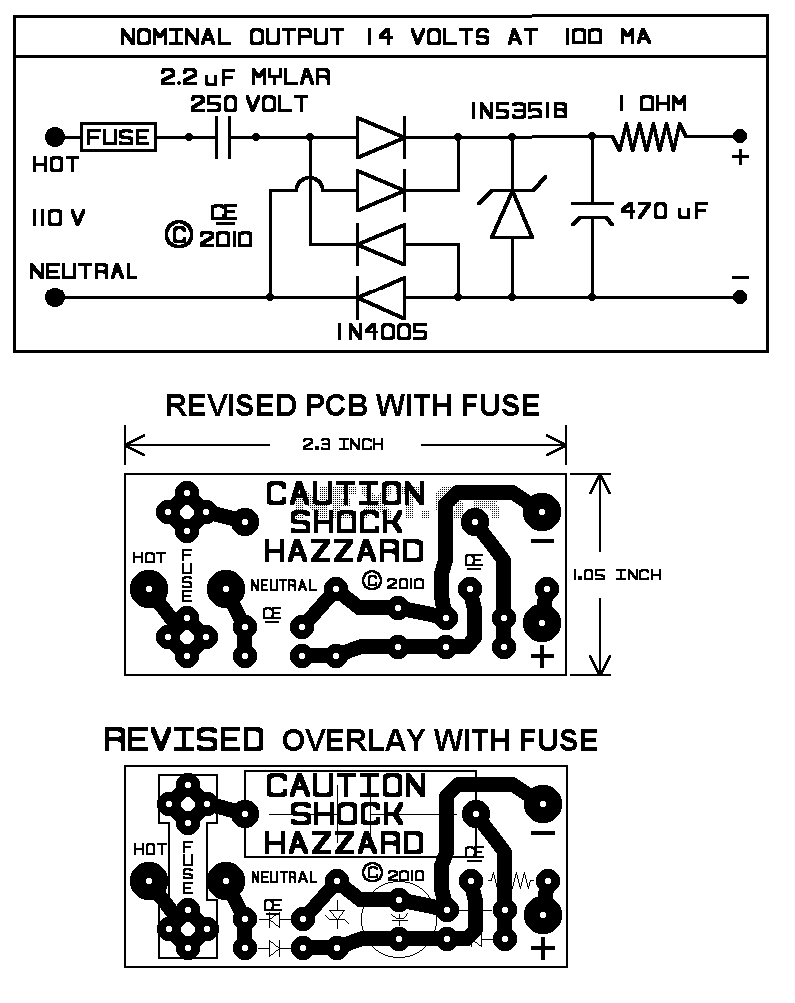
Battery-powered fence charger
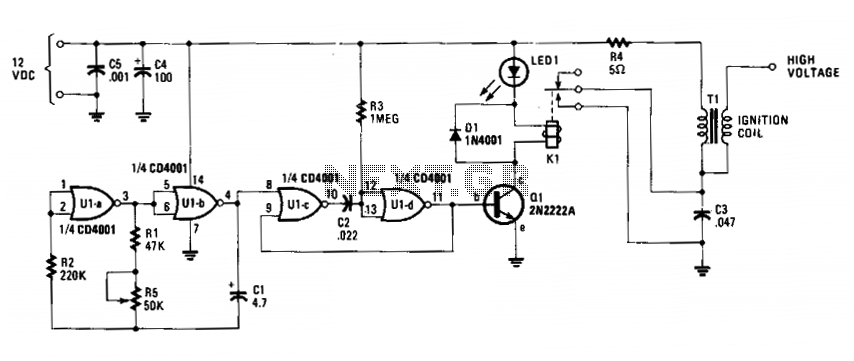
The circuit is fundamentally an auto ignition coil paired with a set of points that perform a similar function. It employs a pulsing circuit constructed from a single CMOS NOR integrated circuit (U1) to open and close relay contacts, thereby simulating the operation of traditional breaker points. The relay pulser is divided into two clocking functions. The first function is a free-running square wave generator that sets the pulse rate or frequency for activating the relay. This function consists of a pair of NOR gates configured as inverters and arranged in a feedback loop, designated as U1-b. The oscillation period of the feedback loop is influenced by timing components C1, R1, and a variable resistor R5.
The circuit utilizes a CMOS NOR gate integrated circuit (IC), which is known for its low power consumption and high noise immunity. The configuration of the NOR gates in a feedback loop creates a stable oscillation, producing a square wave output. This output is essential for controlling the relay, which in turn activates the ignition coil. The relay acts as a switch that modulates the current flowing to the ignition coil, enabling the ignition system to function without the need for mechanical breaker points.
The timing components, including capacitor C1 and resistor R1, along with the variable resistor R5, are critical in determining the frequency of the oscillation. The capacitor charges and discharges through the resistors, creating a time delay that establishes the period of the square wave output. By adjusting R5, the frequency can be fine-tuned, allowing for optimal performance of the ignition system under varying conditions.
In summary, this circuit design effectively replicates the functionality of traditional ignition systems while providing enhanced reliability and efficiency through the use of solid-state components. The integration of a CMOS NOR gate offers advantages such as reduced power consumption and increased durability compared to mechanical systems. This makes the circuit suitable for modern automotive applications where electronic ignition systems are preferred.In essence, the circuit is nothing more than an auto ignition coil and a set of points which accomplishes the same thing. A pulsing circuit made from a single CMOS NOR integrated circuit (Ul), opens and closes the relay contacts to simulate the action of the original breaker points.
The relay pulser is divided into two clocking functions. The first circuit is a free-running squarewave generator that determines the rate or frequency of the pulses that activate the relay. It is essentially a pair of NOR gates connected as inverters and placed in a feedback loop, they are Ul-b.
The oscillating period of the feedback loop is determined by timing components CI, Rl, and variable resistor R5. 🔗 External reference
The circuit utilizes a CMOS NOR gate integrated circuit (IC), which is known for its low power consumption and high noise immunity. The configuration of the NOR gates in a feedback loop creates a stable oscillation, producing a square wave output. This output is essential for controlling the relay, which in turn activates the ignition coil. The relay acts as a switch that modulates the current flowing to the ignition coil, enabling the ignition system to function without the need for mechanical breaker points.
The timing components, including capacitor C1 and resistor R1, along with the variable resistor R5, are critical in determining the frequency of the oscillation. The capacitor charges and discharges through the resistors, creating a time delay that establishes the period of the square wave output. By adjusting R5, the frequency can be fine-tuned, allowing for optimal performance of the ignition system under varying conditions.
In summary, this circuit design effectively replicates the functionality of traditional ignition systems while providing enhanced reliability and efficiency through the use of solid-state components. The integration of a CMOS NOR gate offers advantages such as reduced power consumption and increased durability compared to mechanical systems. This makes the circuit suitable for modern automotive applications where electronic ignition systems are preferred.In essence, the circuit is nothing more than an auto ignition coil and a set of points which accomplishes the same thing. A pulsing circuit made from a single CMOS NOR integrated circuit (Ul), opens and closes the relay contacts to simulate the action of the original breaker points.
The relay pulser is divided into two clocking functions. The first circuit is a free-running squarewave generator that determines the rate or frequency of the pulses that activate the relay. It is essentially a pair of NOR gates connected as inverters and placed in a feedback loop, they are Ul-b.
The oscillating period of the feedback loop is determined by timing components CI, Rl, and variable resistor R5. 🔗 External reference
Warning: include(partials/cookie-banner.php): Failed to open stream: Permission denied in /var/www/html/nextgr/view-circuit.php on line 713
Warning: include(): Failed opening 'partials/cookie-banner.php' for inclusion (include_path='.:/usr/share/php') in /var/www/html/nextgr/view-circuit.php on line 713
